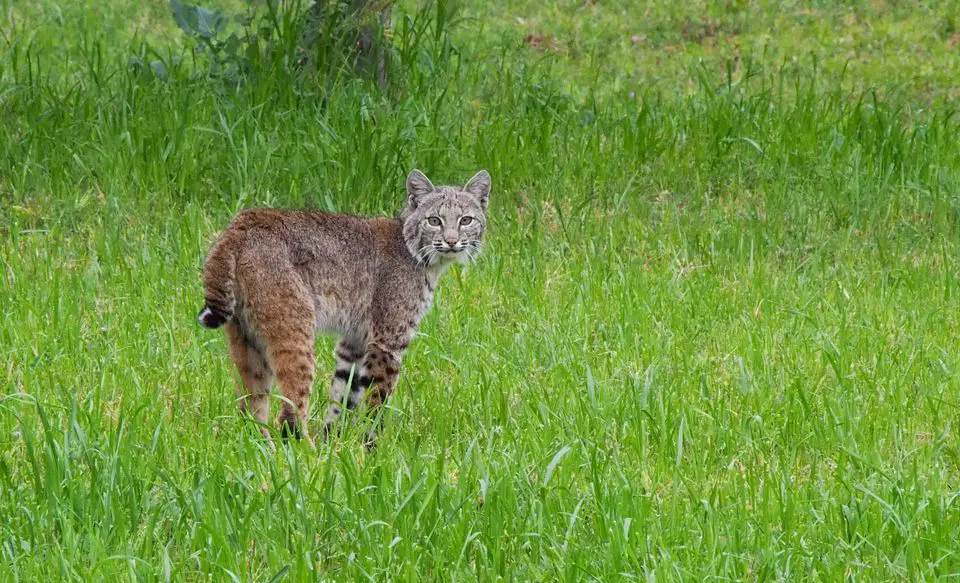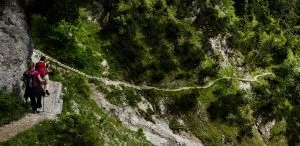What To Do If You See A Bobcat While Hiking

If you’re hiking in an area where bobcats are known to live and roam, it’s important to be aware of their behavior, what they look like, and know what to do if you encounter one. Although they are usually shy, bobcats can sometimes become aggressive if they feel threatened. So in this article, I’ll discuss what to look for when you see a bobcat while hiking and how to react safely.
Quick Links
What Is A Bobcat?
A bobcat is a North American wildcat that ranges in size from about 20 to 40 pounds. So they are pretty comparable to a small dog, such as a Cocker Spaniel. They have a reddish-brown coat with black spots, and their tail is usually about one-third the length of their body.
Bobcats are often confused with mountain lions, but there are some vast differences. For one, mountain lions are much larger, weighing anywhere from 150 to 200 pounds. They also have a long tail that is about two-thirds the length of their body. Essentially, when you think of mountain lion, think “lion,” and when you bobcat, think “cat.” Simple enough.
Another big difference is that mountain lions are rarely seen in North America anymore, as their population has dwindled down to 20,000 to 40,000.
The population of bobcats is currently estimated to be over 1 million across the United States. Although they are found in every state except Hawaii, they are most commonly seen in the southern and western states.
Where Are Bobcats Typically Found While Hiking?
Bobcats are found in wooded areas throughout North America but are most common in the southwestern United States. They are nocturnal animals, so they are most active at night but have also been known to be active during the day.
They like to live in areas with dense vegetation, and they often hunt near water sources. So, if you’re hiking in an area where there are woods and streams, there’s a chance you could encounter a bobcat.
Are Bobcats Dangerous?
Bobcats are not typically dangerous to humans. They are generally pretty timid creatures and would rather mind their own business than bother with us. Out of most of the wildlife you’ll see while hiking, bobcats are typically some of the tamest you’ll come across.
However, there have been instances where bobcats have attacked humans, usually because they feel threatened in some way. They are wild animals, after all, and need to be treated as such. In other instances, bobcats with rabies will act out of character and may become aggressive to humans – for no rhyme or reason.
Additionally, out of all the wild animals, bobcats are legally allowed to be pets in certain states. But even though they may look cute and cuddly, it’s important to remember that they are still wild animals and can be dangerous.
What To Do If You See a Bobcat While Hiking
If you see a bobcat that doesn’t notice you, the best thing is to simply walk away and leave it alone. If you startle it and it becomes aware of your presence, make yourself as big as possible and make loud noises. This will usually scare the bobcat off.
If the bobcat does not run away, or if it starts to approach you in a threatening manner, you may need to defend yourself. The best way to do this is to use pepper spray or bear spray if you have it. If not, try to find a large stick or rock to throw at the bobcat.
Bobcat vs. Coyote: Which is More Dangerous?
So I figured I’d add this here since coyotes and bobcats both tend to weigh the same, are similar in stature, and are both found in North America.
Although coyotes typically live in the western United States, their population has been growing, and they have been moving into more populated areas in the eastern United States as well. This is likely because their food sources (rabbits, rodents, etc.) have also been moving eastward.
Coyotes are more dangerous to humans than bobcats, as they are more likely to attack – especially if you have little ones or smaller pets with you. However, this is usually only in instances where they feel threatened or if they are rabid.
On the other hand, Bobcats are not typically dangerous to humans and will only attack if they feel threatened. So, if you see a coyote while hiking, you should take more precautions than if you were to see a bobcat.
Secondly, coyotes will also eat anything they can find, including human food and trash. So, if you’re hiking and camping in an area where there are coyotes, be sure to properly store your food and trash.
Lastly, coyotes are more likely to carry diseases that can be passed on to humans than bobcats. So, if you come into contact with a coyote, wash your hands and any clothing that may have come into contact with the animal.
Final Thoughts
Bobcats are not typically dangerous to humans, but there are always exceptions to the rule. If you see a bobcat while hiking, make yourself as big as possible and make loud noises. If the bobcat does not run away, or if it starts to approach you in a threatening manner, you may need to defend yourself.
Now that you know a little bit more about bobcats, you can rest assured that if you do encounter one on your next hike, you’ll know what to do. Just remember to stay calm, be vigilant, don’t let the cuddly-ness fool you, and always pack bear repellent or pepper spray – just in case.






